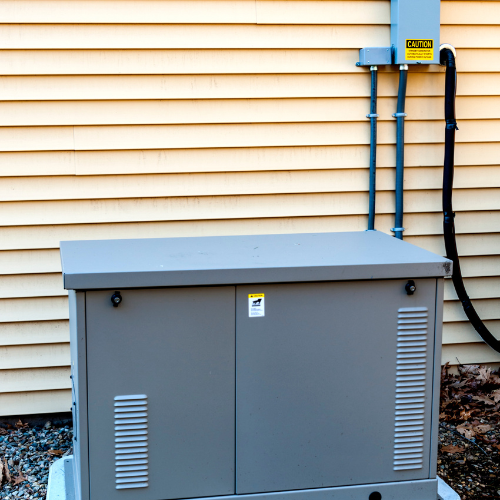Home / Electrical / Generators
Keep the Power On in the Rio Grande Valley
Home Standby & Backup Generator Installation
Stay powered through outages with a properly sized, code-compliant generator setup from Treviño Repairs. We handle load calculations, help you choose whole-home or essential-circuits coverage, and install the right automatic transfer switch or interlock with clean wiring to your panel. Our team coordinates permits and utility requirements when needed, sets the unit on a stable pad, connects natural gas or propane, and completes start-up testing so your backup generator is ready when the grid isn’t. We also offer options like portable generator inlets, surge protection, and maintenance planning—clear recommendations, neat workmanship, and reliable generator installation for homes and small businesses across the RGV.

Power You Can Count On—RGV Wide
Services for Generator Installation & Backup Power
Treviño Repairs designs and installs backup power that fits your property and budget—clean, code-compliant, and ready when you need it. We size the system with a load calculation, help you choose whole-home vs. essential circuits, and integrate the right automatic transfer switch (ATS) or interlock at your panel. Our team coordinates permits when required, sets the generator on a proper pad, connects natural gas or propane, and completes start-up testing with clear owner guidance—so your generator installation is reliable from day one.
We install & service:
- Home standby generators (natural gas/propane), whole-home or essential-circuits
- Automatic transfer switches (ATS) and interlock kits
- Portable generator inlets (L14-30/L14-20) with outdoor power inlet boxes
- Load management modules and prioritized circuit setup
- Surge protection (whole-home) and panel upgrades when needed
Electrical integration & code items (as applicable):
- Load calculation and circuit planning; neutral/grounding verification
- Proper backfeed protection; labeled generator panels/subpanels
- Clearances, working space, and bonding to code; gas/electrical permits when required
Fuel & site work:
- Pad placement and anchoring; condensate/drainage considerations
- Natural gas or propane line sizing and connections (with shutoff and sediment trap as required)
- Venting/clearance guidance for safe operation
Maintenance & testing:
- Start-up checks, voltage/frequency verification, transfer tests
- Oil/filter, battery, and plug inspection schedules; seasonal test reminders
Standby vs. Portable—Sizing, Fuel & Transfer Switching
Standby generators (natural gas or propane) start automatically through an automatic transfer switch (ATS), can cover whole-home or prioritized circuits, and are the most seamless option for frequent or long outages. Portable generators cost less and can work well for essentials when paired with a proper inlet and interlock/transfer switch—you start them manually and choose which circuits to run. The right size comes from a load calculation that considers startup (inrush) for HVAC, well pumps, fridges/freezers, and medical or business equipment, not just the running watts on a label.
Fuel and placement matter for reliability and safety. Natural gas offers unlimited runtime (no refueling) if your gas service stays up; propane is great where gas isn’t available and stores cleanly. Generators need a level pad, proper clearances from doors/windows, and no backfeed risk—meaning a code-compliant ATS or interlock so utility and generator power can’t connect at the same time. Plan for surge protection, periodic exercise/testing, and basic upkeep (oil/battery checks). Treviño Repairs handles the wiring, gas/propane connections, transfer equipment, and start-up testing so your generator installation in the RGV is safe, compliant, and ready when the grid isn’t.

Know the Warning Signs in the Rio Grande Valley
When to Install or Upgrade Backup Power
If your home or business sees frequent or long outages, relies on well/septic pumps, medical equipment, refrigeration, or a home office, or you’re tired of extension cords and manual transfer hassles, it’s time to plan a safer, code-compliant generator setup. Other cues include tripping breakers when a portable is running, an undersized or aging unit, a doorbell-style transfer kit that doesn’t meet code, or a standby generator that won’t start, throws errors, surges, or delays on transfer. Treviño Repairs can size the system, install the right automatic transfer switch or interlock, add a safe inlet, upgrade the panel and surge protection, set the unit on a proper pad, connect natural gas or propane, and verify operation—so your RGV property stays powered when the grid doesn’t.
What to Expect with Treviño Repairs
Our Generator Installation & Startup Process
Assess & Load Calculation. We confirm outage goals (whole-home vs. essentials), review panel capacity, list priority circuits, survey gas/propane availability, and select standby or portable-with-inlet plus the right ATS/interlock.
Scope, Pricing & Permits. You get clear options and a written scope; we handle permits and utility/fuel coordination when required, and plan pad placement and clearances.
Protect & Prep the Site. We mark utilities, set or pour a level pad, plan conduit/fuel routes, and stage materials to keep the workspace clean and safe.
Electrical Integration. Install the automatic transfer switch (ATS) or interlock, add a generator subpanel if used, run conduit/conductors, verify grounding/bonding, and add whole-home surge protection as scoped.
Fuel Connection. Size and run the natural gas or propane line with shutoff and sediment trap (as required), make leak-tested connections, and verify pressure.
Startup & Transfer Testing. Fill oil and connect battery (standby), power up, check voltage/frequency, simulate an outage to confirm transfer and load performance, and set an exercise schedule on compatible units.
Cleanup, Labeling & Walkthrough. We label circuits and equipment, review basic operation and safety (including portable inlet procedures if applicable), provide documentation for inspections, and leave your Rio Grande Valley property neat and ready for the next outage.

Real Stories. Real Results.
What Our Customers Are Saying
EXCELLENTTrustindex verifies that the original source of the review is Google. Very professional. Got the job done very quickly. Would definitely recommend.Posted onTrustindex verifies that the original source of the review is Google. Very professional and answered all questions I asked. Will call again if I have other electrical problems.Posted onTrustindex verifies that the original source of the review is Google. Great Service: We had a leak and couldn’t figure out where it was coming from. Eduardo took his time to find the source, kept me updated throughout the process, and finally discovered it was an AC leak. Just last week, we had paid another company to fix the same issue, but they didn’t do the job correctly. Eduardo explained everything clearly, offered to correct the problem, and even charged less than what we had previously paid the other company. Once he identified the leak, he made sure it was completely taken care of. I called today, and they arrived in less than an hour—excellent service! Eduardo was the best, and I highly recommend him company.Posted onTrustindex verifies that the original source of the review is Google. Great service, super fast and convenient. Valente came out same day, identified the problem in minutes, and built a solution in less than an hour. We appreciated that he provided options and up front pricing.Posted onTrustindex verifies that the original source of the review is Google. Had an electrical issue and called so many electricians. None were available and some didn’t answer at all or return calls. Called Treviños Plumbing, Electric, and HVAC and they scheduled us right away. Our technician, David, was very professional, friendly, patient, and fixed the issue! Great service! Thank you so so much! Highly recommended!!! Hopefully we won’t have any other issues for a while but if we do, I’m definitely contacting Trevino’s!Posted onTrustindex verifies that the original source of the review is Google. Great work by Eduardo, explained the problems thoroughly and fixed them quicklyPosted onTrustindex verifies that the original source of the review is Google. Had an emergency with my water pipe outside of my home. From what started with a leak water would not stop running, ended up being a whole fountain.(Water everywhere). Super panicked I call Trevino’s and they came to the rescue as quick as possible. So grateful and thankful for David D, he took our call and fixed our issue. Super fast service and arrival time 5 stars all the way. Thankyou so much.Posted onTrustindex verifies that the original source of the review is Google. Lee cordero from brownsville tx.This company went above and beyond for my dad.We called 3 other companys that were no show.This company is the best and they really work with your schedule and there super affortable and take there time to do the best work possible. My dad a vet and he has been dealing with this ac issue for months this company and there techos took there time for my dad when no else did hands of best company to go with .I highly recommend them .Thank you Tervino team. Antonio finally put my family at ease with this ongoing issue that no one else could figure out.Posted onTrustindex verifies that the original source of the review is Google. 5 stars, fantastic service! I will only hire this company from now on!!!!Posted onTrustindex verifies that the original source of the review is Google. Jiovanni, came by today for a call back at our house. He was pleasant professional, and quickly took care of the problem. We were very impressed with the service and the company. I praise God for the quick response, thank you again!Verified by TrustindexTrustindex verified badge is the Universal Symbol of Trust. Only the greatest companies can get the verified badge who has a review score above 4.5, based on customer reviews over the past 12 months. Read more
Generator Questions, Answered
Straightforward answers before you book—symptoms, costs, fixes.
What size generator do I need—whole-home or just essentials?
Sizing comes from a load calculation that includes startup (inrush) for HVAC, pumps, fridges/freezers, and any medical/office gear. We’ll help you choose whole-home coverage or an essential-circuits setup that powers only what you need during an outage.
Standby vs. portable—what’s the difference?
Standby units are permanently installed, start automatically via an ATS, and can run for extended outages. Portable units cost less and work well for essentials when paired with a code-compliant inlet and interlock/transfer switch, but they’re manual to start and manage.
Natural gas or propane—what’s better?
Natural gas offers long runtimes and no refueling (if gas service stays up). Propane is ideal where gas isn’t available and stores cleanly; you’ll size the tank for expected runtime. We verify fuel line sizing and pressure for safe operation.
Do I really need a transfer switch or interlock?
Yes. A transfer switch/interlock prevents dangerous backfeed into the utility lines and isolates your home safely. It’s required for code compliance and for the safety of your household and utility workers.
Are permits and inspections required?
Often, yes—especially for new circuits, ATS/interlock installs, service upgrades, pad placement, and gas/propane connections. We coordinate permits and inspections when required and provide clear documentation.




